To thrive as a small business, you need press coverage. But, unfortunately, coverage doesn't just come naturally – you need to work for it.
Enter: the press release.
Press releases are important for increasing your brand awareness and helping your public relations (PR). But if nobody sees your release, you won't get very far. You need to distribute it effectively to get your story picked up by local and/or national newspapers, magazines, or blogs.
In this guide to press release distribution, we'll cover the following to help you put together a plan of action that results in coverage:
- What is press release distribution?
- Why is press release distribution important?
- How to distribute your press release
- Distribution mistakes to avoid
- Should you use distribution services?
Keep reading to learn how you can properly create, pitch, and distribute a press release for optimal brand awareness.
What is press release distribution?
Before we dive any deeper, let's iron out exactly what press release distribution is.
It's the process of circulating or seeding out your press release to journalists, publishers, and members of the press.
Your press release normally provides updates on your company's products and/or services, projects, partnerships, organization structure, and more. With distribution, you allow various publications to share your press release and thus, reach a wider audience.
Why should you submit a press release?
The purpose of distributing a press release is to land coverage in media publications, such as newspapers, radio, TV news bulletins, podcasts, and blogs. That way, you're positioning your brand in front of a wider audience.
If you only post your press release on your website, most consumers won't know about it – which defeats the entire purpose behind writing your press release.
Gaining press coverage helps to get your business or brand name into the public forum. That helps build brand awareness – especially when 71% of journalists consider press releases to be their favorite type of content to receive from brands.
Distributing a press release also has these benefits:
1. Press releases can boost your SEO.
Over three billion Google searches are made every day.
Implementing SEO tactics into your overall marketing strategy will help you rank high for your target audience's search queries. This means that you're that much closer to reaching potential customers as they search online for information related to your company, industry, product, or service.
Gaining backlinks to your site from high-authority websites is a huge ranking factor for SEO, as explained in a 2021 study by Backlinko:
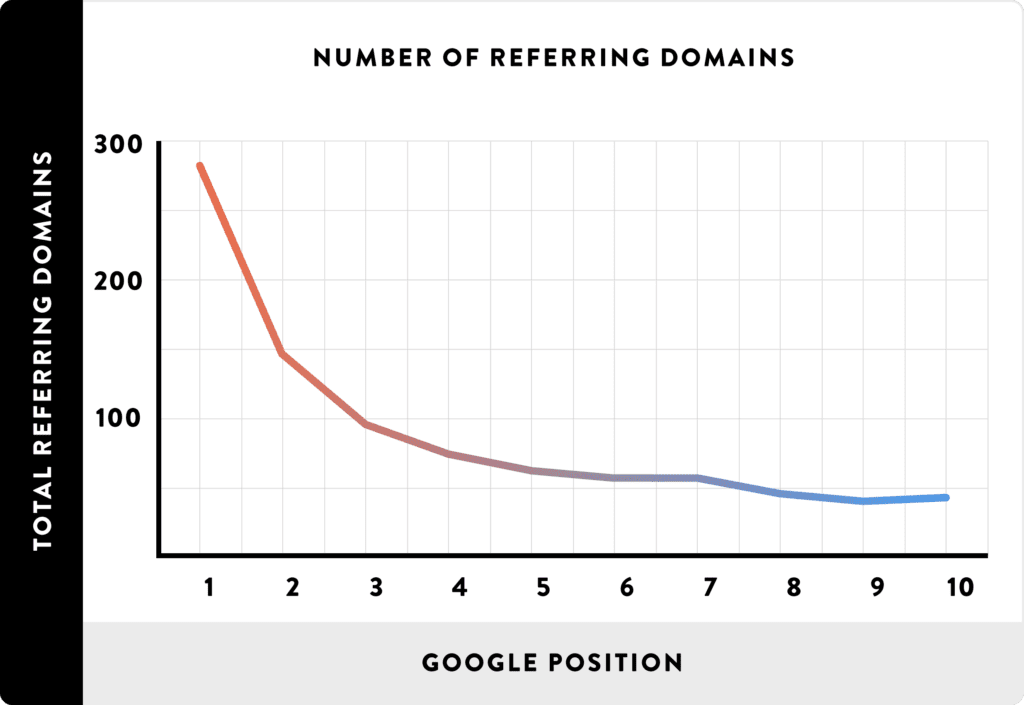
Distributing press releases can help you land coverage on huge publications. Additionally, there's a chance those websites will link to yours, which can help to boost your search engine visibility.
But what happens if you land awesome coverage without a backlink?
Don't panic – In the past, Both Google and Bing have suggested that positive brand mentions can play a role in how they rank your site, meaning positive PR coverage can aid your SEO efforts even without a link.
2. A press release can drive local foot traffic to your store.
If your business is a brick-and-mortar shop, press release distributions can help to get people through the door.
Whether you're running an event or simply launching an eye-catching sale, measuring foot traffic into your store after distributing a press release is a simple way to gauge how successful your release has been.
3. A press release can generate more sales.
If you're launching a new product or an exclusive line, a targeted press release can have a significant impact on your bottom line. Why? Because it helps drum up interest if it's innovative and sets you apart from competitors.
Busy shopping days can be a great way to get your products in front of potential customers.
For instance, if you're offering discounts on Black Friday or Cyber Monday, why not reach out to retail journalists to highlight your offers?
Should you use press release distribution services?
Distributing a press release sounds time-consuming, doesn't it? If only there was a way to get yours seeded out quickly, at scale.
Fortunately, there is.
If you're on a tight schedule and don't have time to manually reach out to local or national publishers, a press release distribution service is the perfect solution.
These services allow you to send out your release to relevant journalists without doing any of the manual work yourself.
While it does cost to use these services, they can save you hours of work. By letting the experts distribute your news story, you can spend time focusing on other tasks.
So, if you fancy taking distribution off your plate, check out these 10 services.
1. Newswire
Newswire is one of the top distribution service providers available in the market. When using the top-rate company, your press release can reach major news outlets, such as NBC, MarketWatch, and NBC.

Newswire also offers multitarget layering for you to reach your desired audience at the local, state, and regional levels.
Furthermore, the service provider follows a strict editorial process to ensure your press release is error-free when it reaches consumers.
Pricing: Starts at $199 per release and goes up to five figures based on the number of press releases you want and the industries you're targeting.
2. eReleases
With a media database of over 1.7 million contacts, eRelease is a distribution service you should consider.
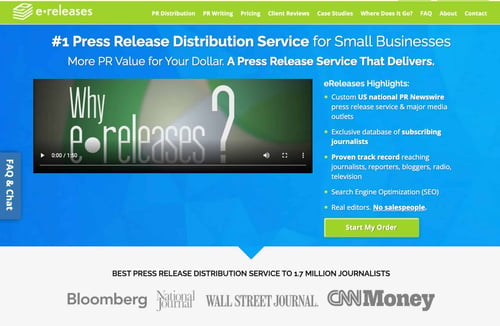
The brand has nurtured relationships with publishers, including influencers and reporters, for over 20 years and promises to include curated emails that will increase engagement.
In addition, eReleases optimizes your press release using white hat SEO practices to increase its chances of ranking on search engines. Furthermore, you can expert a detailed report after distribution with metrics on engagement, audience, and traffic.
Pricing: Starts at $299 and goes up to $599, excluding certain add-ons.
3. EIN Presswire
EIN Presswire is a leading distribution service with affordable pricing.
With one of the quickest reviewal processes, EIN Presswire only takes about an hour to approve your release during the normal weekday hours. Once your release is distributed, you will gain access to a dashboard that will start populating after two hours.
In addition, EIN Presswire is a high authority website through which you can earn backlinks and reap the benefits on search engines.
Pricing: Starts at $49.95 per release and goes up to $999 for bundles.
4. PR Distribution
PR Distribution provides distribution services in both the U.S. and the U.K.

Their starter press release package offers a guarantee of 25 placements, ensuring your story will be seen by your target audience.
Every other package offers an unlimited word count, a multi-tiered editing process, and access to ABC, NBC, and other news outlets.
Pricing: Starts at $99 and reaches up to $1,300 for bundle packages.
5. PR Newswire
Whether you're looking for print or online distribution, PR Newswire is a great option.
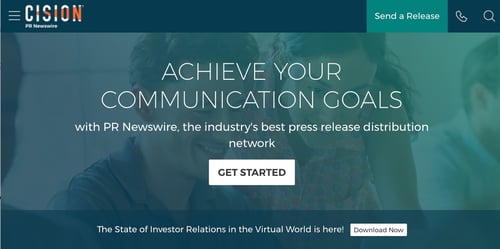
PR Newswire helps connect you to leading publishers in a wide range of industries.
If you're looking for accurate data on your release's performance, this provider's got you covered. You can monitor and measure the impact of your story, and gain insights for future releases.
Furthermore, PR Newswire has a network of over 4,000 websites and 20,000 email subscribers. With a host of distribution channels, it's up to you to decide which one will work best for your brand.
Pricing: Not published on their website.
6. 24-7 Press Release
Using a cloud-based platform, 24-7 Press Release distributes your news to traditional and digital outlets.
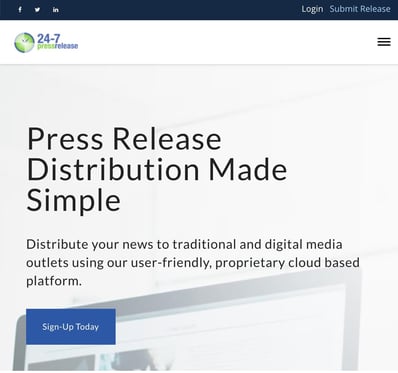
24-7 Press Release follows a strict reviewal process to ensure your press release is ready to be distributed and follows their guidelines.
With a two-day turnaround time, their starter pack allows you to include up to five industry categories, four images, or documents and be sent to over 50 premium news sites.
The more advanced packages come with next-day turnaround, which is helpful if you have a tight deadline.
In addition, you'll receive a report that tells you if and where your story was picked up.
Pricing: Starts at $19 per release and goes up to $389 depending on the distribution package you select.
7. PR Web
PR Web is a tool owned by Cision, a PR and earned media software company.
Their press release distribution service allows you to upload your press release (along with rich media like images and videos), then distribute the story to journalists and publications in your selected categories.
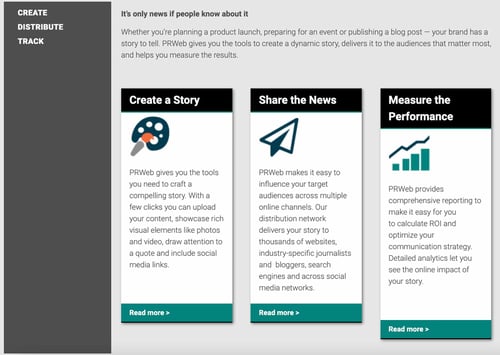
PR Web also provides you with a comprehensive analytics dashboard, so you can monitor the impact of your campaign and calculate important metrics, such as ROI.
Pricing: $99 to $389 depending on the distribution package you select.
8. Response Source Press Release Wire
Response Source is a UK-based distribution service connecting brands with top UK publishers and journalists. With over 20 years of experience, the company has built a thriving network of journalists and publications, so you can benefit from having your news distributed by email to useful contacts.

In a few simple steps, you can upload your release, set the date for publication, attach your media, select the categories, and choose your distribution channels.
You'll also get your own "newsroom," along with access to analytics, such as the number of views your press release received and email open rates.
Pricing: Starts at £85 per press release for ad hoc users and goes up to £1050 for bundles.
9. Presswire
Presswire has a live global database, allowing you to send your press release directly to the journalists who are most likely to pick up your story.

One standout feature from Presswire is the ability to translate your press release into any language and leverage geo-targeting to deliver it to the appropriate regions.
This distribution service also offers an advanced analytics platform, providing insight on:
- Who opened your press release.
- Whether your release was forwarded.
- How many times it was read.
- How long people spent reading it.
These insights can help you refine your approach for future press releases.
Pricing: Starts at £150 and goes up based on the distribution package and add-on services you select.
10. PR Fire
PR Fire syndicates your release to newswires and journalists in the US and UK in your chosen industry categories – all within four business hours after receiving your content.
The press release is also published on the platform's social media pages and site.
Additionally, two weeks after your press release is distributed, you receive a report detailing its performance.
PR Fire also offers a copy-editing service, in which a professional edits or rewrites your press release.
PR Fire has landed its customers press coverage in a range of top-tier publications, including BuzzFeed, Metro, The Huffington Post, and The Times, so it's worth checking out.
Pricing: £50 to £150 per press release depending on the distribution package you select.
You know how important PR is, and you've crafted a succinct, yet powerful, story. All that's left to do is share it with the world.
But journalists have to write up to seven stories per day. So how do you ensure your press release is one of those stories? And just as importantly, how can you make your distribution email stand out in a crowded inbox?
Follow this five-step guide to learn how.
1. Find journalists who might be interested in your press release.
When have news to share, I'll bet you're tempted to tell as many people as possible. You want everyone to hear about it, right?
However, that's not always the best strategy.
After crafting a great press release, you can identify journalists who may be interesting in creating a larger story surrounding your news.
You can do that by searching for journalists and publishers who've already written about your topic or industry.
For instance, let's say you run a car parts business. You've conducted some research around potholes, gathered some interesting data, and turned it into a killer press release. But mailing every journalist under the sun is probably going to be a waste of time.
Instead, it's worth seeking out publishers who cover the automotive industry and journalists who've covered similar topics before.
To do this, fire up Google, type in your topic (potholes), and navigate to the News tab:
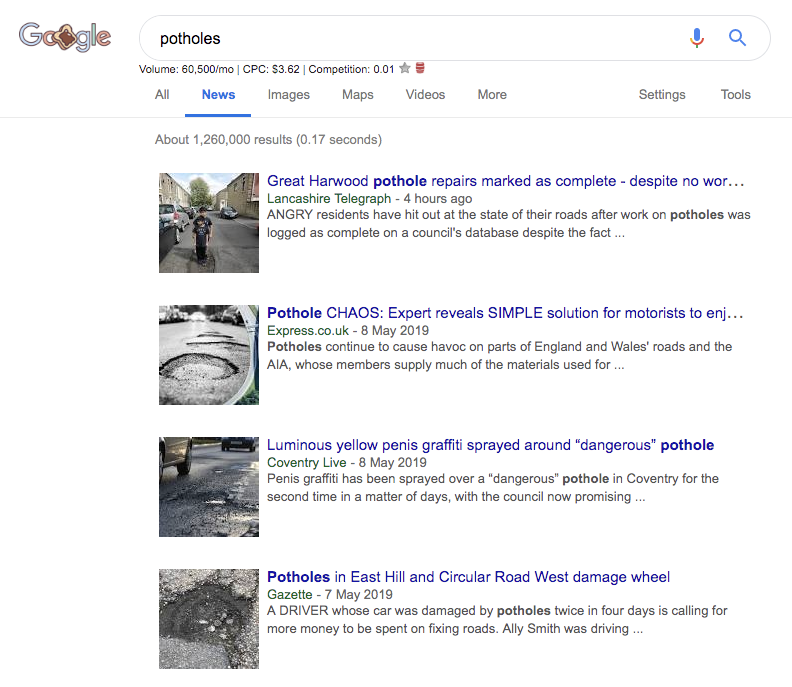
As you can see, there are plenty of recent articles on this topic, meaning journalists are more than likely interested enough to cover it.
Next, read some of the articles on Google News and make a note of the journalists' names.
A simple spreadsheet with the journalist's name and the publication they write for is a good way to keep a log of your distribution plan:

If you have the budget, you can also use a media database, such as Cision or Muckrack to find relevant journalists and reporters.
This method is much more likely to get you responses because you're only pitching the release to journalists who've demonstrated an interest in your topic.
2. Get the journalists' contact details.
Next, it's time to find some contact information for the people on your press release distribution list.
This could be as simple as clicking on an author's bio on their publication's site.

... and making a note of their email address:

But, just like anything else in the world of PR, it's not always that easy.
You'll often have to do a little digging to find the contact details – starting with a simple Google search such as "[Journalist's name] email]".
If that doesn't do the trick, you could also use a media database like Muckrack:
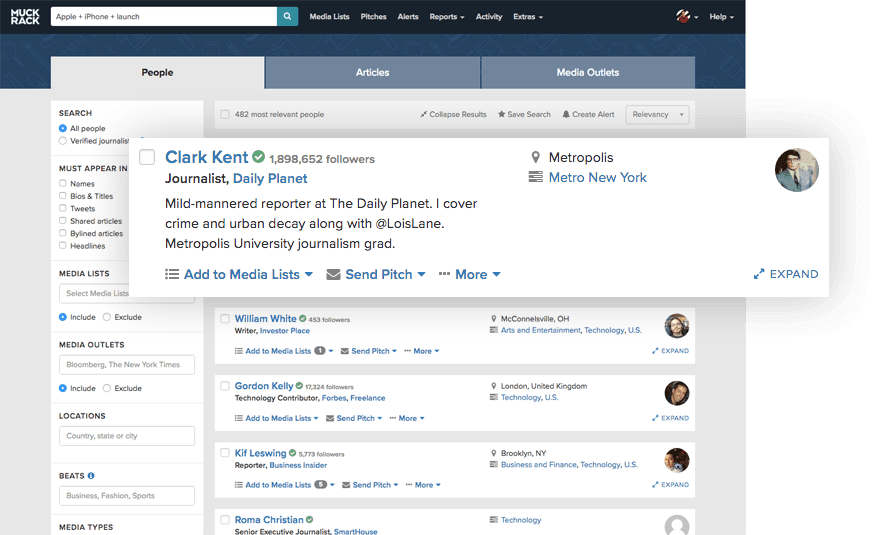
Don't have the budget for paid databases? Harness the power of social media.
LinkedIn is an excellent place to discover contact information for professional contacts (AKA, your journalists). Simply search for "journalist" and filter the results by selecting your target publication as "company," then plug their name into Hunter to find their email address:
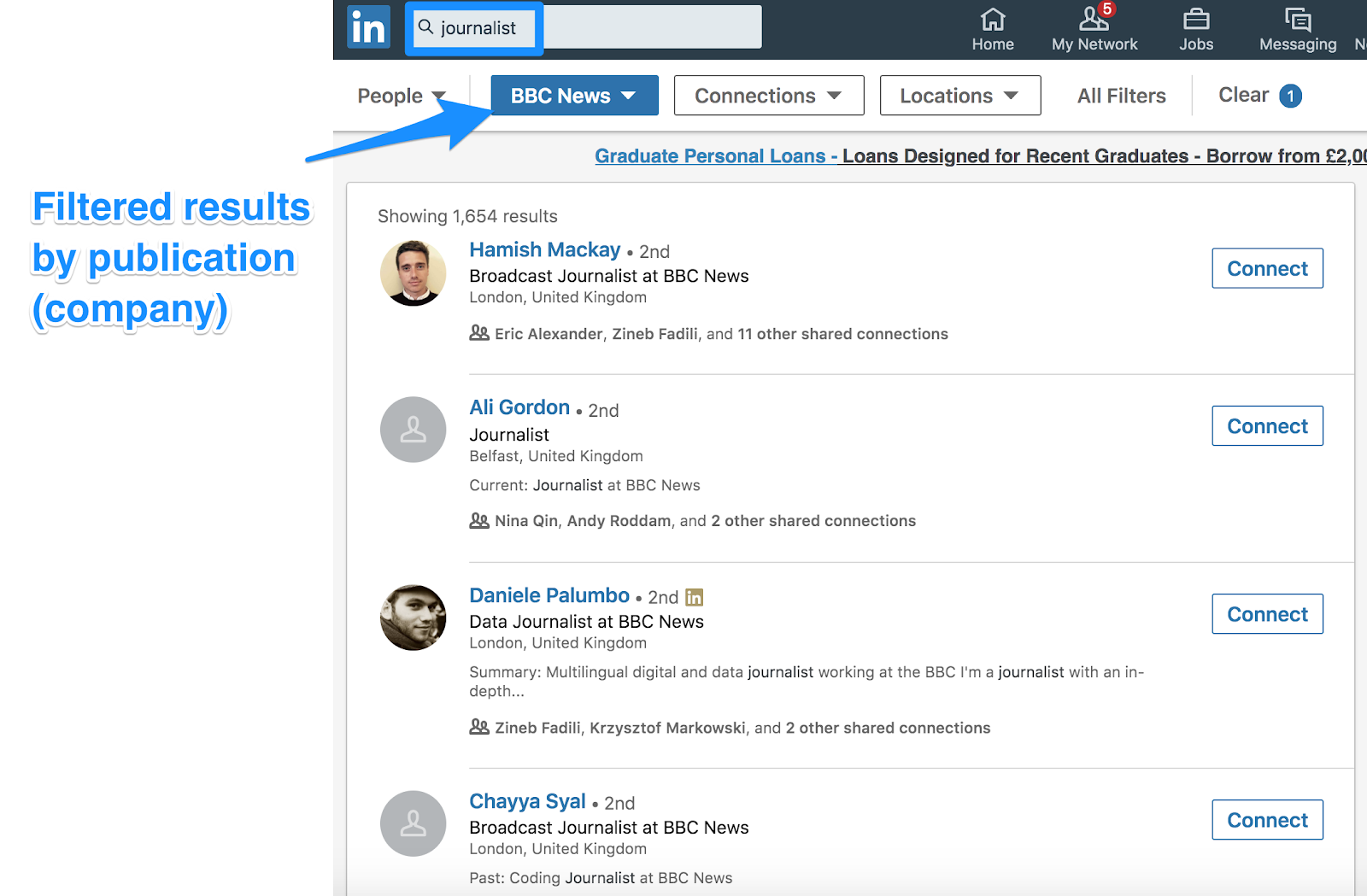
Twitter can also be a quick and easy way to get in touch with your target journalists, too.
3. Craft a killer pitch.
Email is the most effective way to send your press release quickly.
However, there's another obstacle you'll need to overcome here: Journalists can receive up to hundreds of pitches a day.
So here's what you should do to stand out: First, keep it brief.
Don't waste the journalist's time with a long-winded, self-absorbed introduction to yourself or your business. They probably don't care.
Instead, get straight into the purpose of your email: The story, and why they should cover it in their publication.
Journalists are time-poor, so they'll appreciate a nice, succinct message that sells your story in a few words – like this:
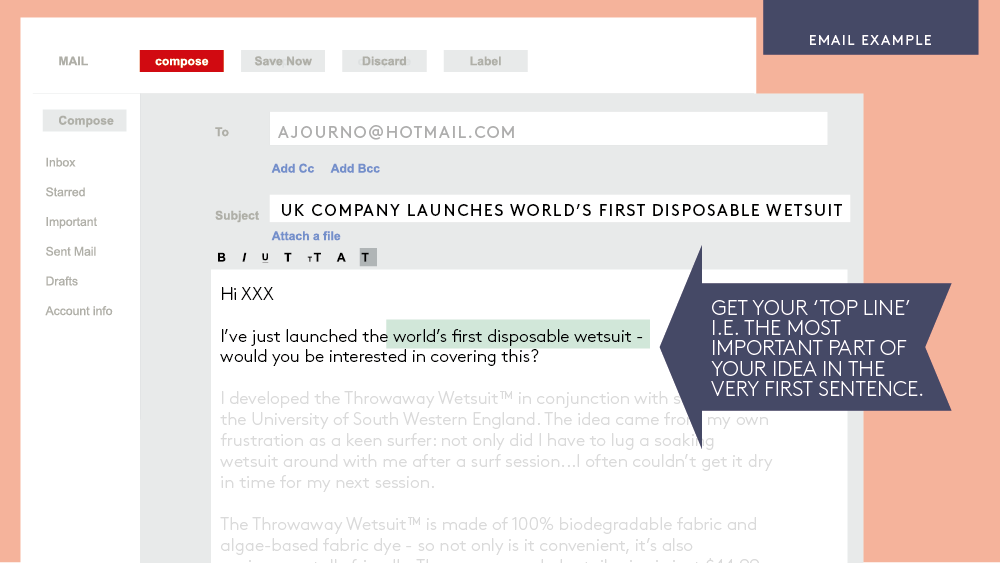
As you can see in the example above, the entire story is sold in the first sentence, with a direct question asking if the journalist is interested – rather than just assuming so.
Follow this up with a couple more sentences to give the journalist some additional context, before adding a line spacer and pasting your full press release.
Note: Avoid adding your press releases as attachments. Journalists don't like opening attachments in fear of viruses or malware, so eliminate that problem by pasting the body of your press release below your pitch.
Second, you must personalize your pitch.
Show some interest in the journalist's previous work by indicating that you know they're a good fit based on the topics they cover.
Try to build a relationship with the journalists first, rather than hitting them with a release and expecting instant coverage.
Sometimes, it's worth playing the long game by getting to know your desired publisher ahead of your pitch. Engage with them on LinkedIn, respond to their tweets, and generally work yourself into their notifications – and their radar.
3. Make your subject line irresistible.
What's the first thing you look at before you open an email? The subject line, right? In many cases, it plays a big role in the email open rate.
So, how can you make sure yours gets opened? Try these tips:
- Keep it short and sweet: Ideally, 10 or fewer words.
- Ensure it's unique: A powerful subject line should be disruptive, innovative, or offer a human-interest angle.
- Be specific: Your subject line should be descriptive enough to let the reader know what to expect when they open the email.
- Provide exclusivity: If you've got some unique data or research, mention that. Exclusivity can help you grab a journalist's attention.
… And one thing to avoid? Clickbait. It's that simple.
4. Send your press release pitch (at the right time).
Press release? Check. Pitch email? Check. Contact details? Check.
… But that doesn't mean you're ready to distribute your press release.
You'll need to think about the day (and time) you hit the "send" button because certain days and times have better success rates than others.
For instance, some journalists may prefer to sift through pitches in the morning. While others may prefer mid-day or late afternoon.
It's often a trial-and-error process that you should keep note of.
Additionally, it's important to consider the day of the week. While modern-day businesses are often active seven days a week, there's still a traditional lull in pick-up rates when it comes to press release distribution.
So, consider the day you send your release -- it might land more coverage if you pitch it midweek, as opposed to sending it first thing on Monday morning.
5. Follow-up on your release.
An age-old question: Should you follow up on your pitch if it doesn't get traction?
It depends on who you're asking, but generally, the consensus seems evenly split. Some people believe following up to be a big no-no, while others indicate that it can be fruitful.
If you have a release you're particularly proud of, it won't hurt to follow up if you're struggling to land coverage – provided you're tactful.
Don't spam the journalist's inbox with the same press release and the same pitch. That can get annoying, and ruin your chances of getting your story picked up.
Instead, try tweaking the angle of your pitch to something that highlights why they should care about this story.
How to Submit Local Press Releases
Local press releases are great for small, brick-and-mortar businesses who want to reach consumers who are in their area.
That's why it's beneficial to send out your press release to local newspapers, publishers, and journalists.
Many of the guidelines outlined above still apply. What's different here is that you can take a more personal approach to your pitches as well as distribution channels. For instance, you can target local radio and TV stations that may be interested in mentioning your story.
Press Release Distribution Mistakes
All set to send your next press release? Hang on a second.
Here are some common mistakes people make, and how you can avoid them when you distribute your press release.
1. Your press release is too long.
Your story needs to be short and succinct.
The easiest way to get your press release read is to cut the fluff. Remove any sentences that won't add value to the reader.
Your press release needs four main sections:
- Paragraph to introduce the news.
- About two to three paragraphs to dive into the "what" and "why" of the news.
- About and contact information.
Remember: Every sentence counts.
2. You're targeting the wrong people or publications.
If you work for a small business looking to get some coverage, you're going to get the most success from contacting local publications.
A local business story is rarely important enough to make national news.
You should also double-check that your target journalists are a good fit. Many tend to specialize in one or two interests – emailing a sports reporter about a press release related to health isn't likely to result in coverage.
3. Your story isn't newsworthy enough.
Before hitting send and distributing your release, take a moment and ask yourself: "Is this story actually newsworthy?"
If your release is too self-promotional, it may not interest your target audience.
Ensure it's got a relevant angle and includes information and/or data pertinent to the story.
Accompanying quotes are also great, as they bring the story to life, rather than over-selling your own company. For instance, say you're partnering with another brand, consider including a quote from the other brand's CEO, which explains their interest in wanting to partner with you.
4. You didn't include your contact info.
Imagine crafting that story, pitching it, and finding an interested reporter who wants to contact you for a larger story. But the journalist hits a dead end and is unable to contact you.
Unfortunately, if you don't include your contact information in the press release, you risk losing out on the chance for increased exposure.
You need to make it easy for journalists to contact you by leaving a phone number and email address in your press release distribution email.
Remember to Keep the Relationship Alive
When you need to create a press release, follow the distribution steps in this guide to boost your chances of landing coverage.
Keep tweaking and refining your approach until you see success. Your first piece of coverage could well be the domino that starts the run. A story picked up by one news outlet can soon snowball from publication to publication.
Plus, if your story does get picked up, don't forget to thank the journalist. It can facilitate a relationship that you can then nurture and facilitate easier coverage down the line.
Ultimately, you can never have too much good press!
Editor's note: This post was originally published in November 2019 and has been updated for comprehensiveness.
Press Release Distribution: Top 10 Services + 4 Mistakes to Avoid was originally posted by Local Sign Company Irvine, Ca. https://goo.gl/4NmUQV https://goo.gl/bQ1zHR http://www.pearltrees.com/anaheimsigns

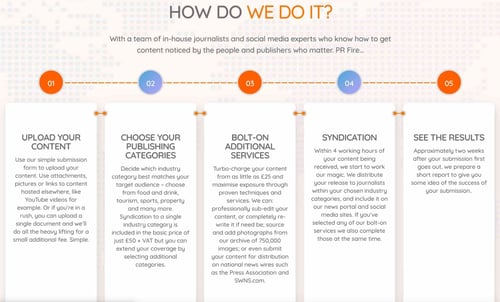
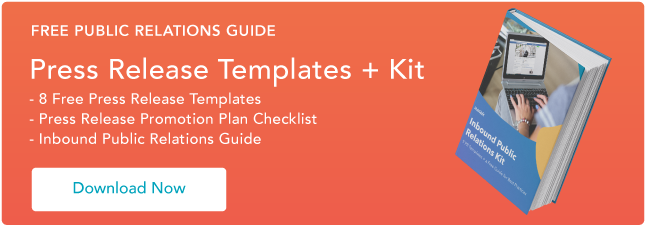
1 comment:
Good.
Post a Comment